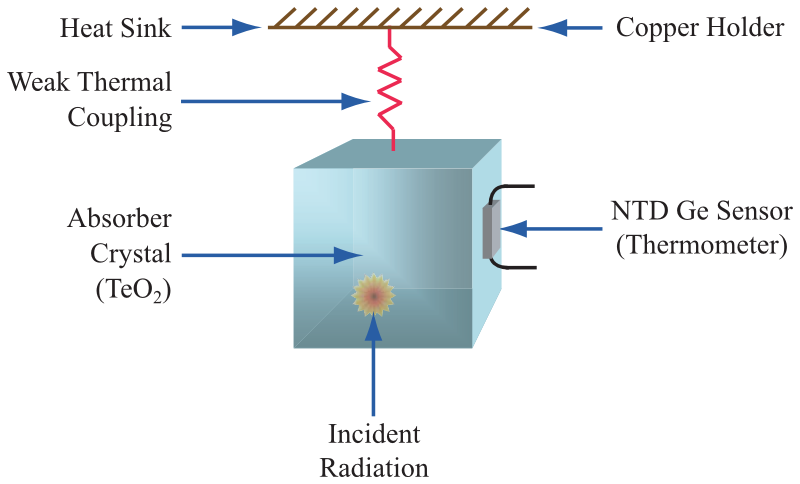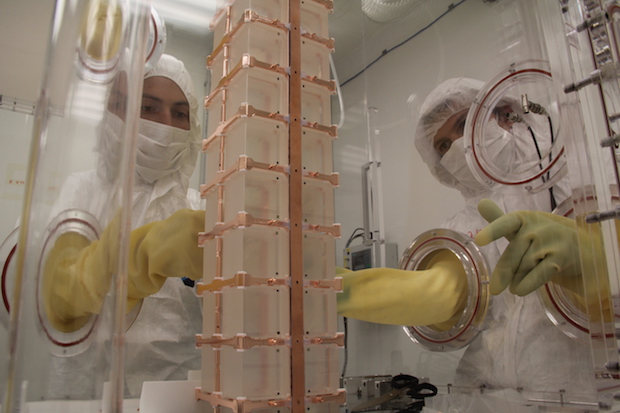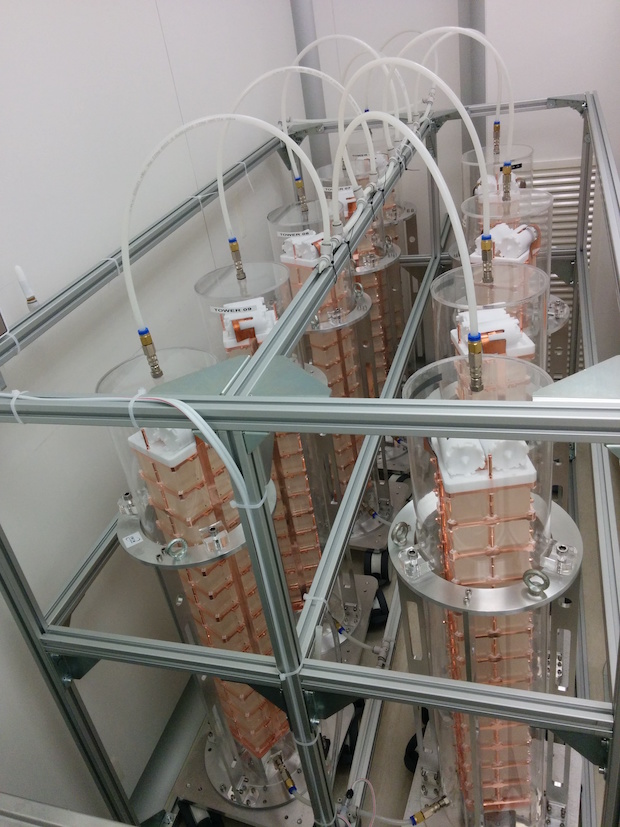Detectors

One major advantage of crystal bolometers for a 0νββ search is that the crystals can be grown from the double-beta-decaying isotope. When the source is fully contained inside the detector, as is the case in our bolometers, the emitted electrons are nearly always observed. In 1984, Ettore Fiorini proposed using bolometers to search for 0νββ decay. In particular, TeO2 crystals were chosen to investigate the decay of 130Te, as bolometers made from TeO2 can be made extremely radiopure and with an excellent energy resolution (0.2% at the 0νββ energy region of interest).
Ten years later, Fiorini's research group demonstrated the potential of this idea by successfully operating a single 340 g TeO2 crystal. In 2003, MiDBD, an array of 20 crystals (with a total mass of 6.8 kg of TeO2), published results that paved the way to develop large-mass bolometric detectors. Cuoricino (2003–2008) and its successor, CUORE-0 (2013–2015) have published compelling results. These experiments did not observe 0νββ decay in 130Te, but allowed us to set the most stringent limit to date on its half-life: 4.0 × 1024 years at 90% C.L. CUORE aims to improve the sensitivity of this half-life up to 1026 years by using a mass 19 times larger than that of CUORE-0, and decreasing the background rate in the region of interest.
The first large-mass array: Cuoricino

The successor to Cuoricino: CUORE-0

Building on the experience of Cuoricino to reduce radioactive backgrounds, we redesigned the detector support structure to minimize the amount of material used, especially copper. We also found more radio-pure copper and developed techniques to clean it better.
To build CUORE-0 and the 19 CUORE towers, we designed a semi-robotic and semi-manual assembly procedure in a cleanroom. This procedure avoided recontaminating clean materials and, at the same time, improved the uniformity of the detectors.
CUORE-0 was operated in the Cuoricino cryostat from March 2013 to March 2015. It showed that the improvements to the construction and assembly procedures were very effective: the α-particle background was reduced by a factor of 6, and the crystals showed a more consistent and, on average, better resolution than those used in Cuoricino.
CUORE

The 19 towers will be arranged inside the new CUORE cryostat in a tightly packed array. This arrangement lets us look for coincident signals between detectors, and it shields the towers in the inner layers against radioactivity produced by the experimental environment.
To predict the background rate in CUORE, we can extrapolate from the background rate measured in CUORE-0. The rate is expected to improve because the cryostat is more radio-pure and the towers can shield each other. We expect a total background of 10–2 counts/keV/kg/y (~200 total counts over 5 years) in the energy region of the 0νββ decay.
Assuming the same detection efficiency and energy resolution seen by CUORE-0, and 19 times larger detector mass, CUORE will achieve a sensitivity on the order of 1026 years for the half-life of 0νββ decay, corresponding to a sensitivity to the Majorana mass of neutrino around 40–100 meV.
The CUORE towers were assembled using the same production line as CUORE-0, and they are now stored in a cleanroom in the underground laboratories of LNGS under nitrogen flux to prevent possible contamination.
We will install the towers and begin detector operations in 2016.
Beyond CUORE
A further enhancement of the sensitivity of bolometric experiments requires an increase in mass and an improvement in background suppression of one or two orders of magnitude.
The most straightforward way to increase the detector mass is to enrich the crystal in the isotope of interest. The isotopic enrichment is feasible for most of the 0νββ emitters. Nevertheless, it is expensive, requires dedicated facilities, and may introduce radioactive or chemical contaminations in the final material that could spoil the crystal quality.
The challenge for improved background suppression gave birth to many projects that aim to develop active background rejection tools. Most of these R&D activities focus on the possibility of identifying the nature of the interacting particle in order to distinguish a signal event (electrons) from backgrounds due to alpha particles. This particle identification can be obtained by coupling to the bolometer a second, independent device for light read-out. The success of the projects devoted to the development of sensitive light detectors is crucial to prove that an effective background suppression is within reach.
So far, large bolometric 0νββ decay experiments have only used TeO2, but bolometers can be grown from almost any 0νββ decay candidate isotopes. Observing 0νββ decay would be a huge breakthrough for modern physics, so it is important to search in a variety of different isotopes. Experiments using different isotopes can also verify each other's results. The CUORE collaboration and other groups are investigating several kinds of crystals grown with various 0νββ decay candidate isotopes.
